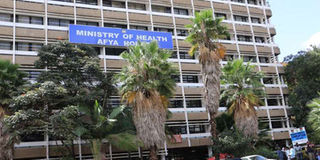Interesting findings by audit team in imported clinics saga

Afya House, the headquarters of the Ministry of Health, in Nairobi. PHOTO | JEFF ANGOTE | NATION MEDIA GROUP
What you need to know:
Let’s face it, the project to purchase those mobile clinics was poorly conceived, over-priced, and had little or no economic justification beyond creating rent-seeking opportunities for public officials and the suppliers of the equipment.
This is the inescapable conclusion I have reached after reading through an audit report by the National Treasury on the mobile project saga titled “A quality assurance review” on procurement and payments by the Ministry of Health.
Why isn’t someone at Afya House being punished for the mobile clinics scandal? How long must it take to investigate such blatant cases of corruption by public officials?
Let’s face it, the project to purchase those mobile clinics was poorly conceived, over-priced, and had little or no economic justification beyond creating rent-seeking opportunities for public officials and the suppliers of the equipment.
This is the inescapable conclusion I have reached after reading through an audit report by the National Treasury on the mobile project saga titled “A quality assurance review” on procurement and payments by the Ministry of Health.
It has now emerged that following the exposes of the mobile clinics scandal in the media and after the ministry put out its response to the allegations, the National Treasury assembled a three-man independent team of top auditors to conduct “a quality assurance review” on the saga.
The findings of the independent review team are critical in the search for the truth behind this saga because the purpose of the audit was to go beyond what is contained, on the one hand, in the story by Mr Bernard Muchere, whose initial report leaked to the media – and on the other hand, the defence and reports which the ministry had put out to support its case.
The report highlights many issues, but here is what I personally find most revealing in the review by the three-man Treasury team. First, the audit found that the ministry went ahead to spend a whopping Sh800 million to import and purchase 100 of these portable clinics before doing something as rudimentary as hiring the staff who will man the facilities.
SPELT OUT
Secondly, clear plans on when and how the equipment was to be installed and commissioned were not spelt out before it was imported and vendors paid.
For instance, the auditors found that the agreement between the ministry and the vendors of the equipment – Messrs Estama Investments Ltd – did not provide details such as deadlines for delivery, quality and quantity inspections and payment conditions.
Apparently the Treasury team visited Mombasa to physically examine the containers and verify their contents. Here is what they found.
They found 99-40ft long containers modified as medical clinics. They were informed that one clinic had been delivered to State House for demonstration. And, what did they find inside the containers? All manner of items ranging from cooler boxes, thermometers, pulse oximeters, and medical trolleys to stethoscopes.
The auditors fell short of questioning the value of the contents of the containers and whether they represented value for money.
But they said that when they examined the tender documents such as technical and financial evaluation documents, it was not clear to them whether the items in the containers had been costed.
The whole sag begs the following question: Considering that we did not have a national epidemic at the time these mobile clinics were bring imported, why were we hurrying to import and to pay hundreds of millions of shillings for these contraptions even before we determined where the staff to man them would come from?
Where was the economic rationale for spending such large sums of money on these small white elephants when more deserving priorities such as purchase of essential drugs have been suffering from chronic underfunding?
DISTRIBUTED HAPHAZARDLY
According to the schedule of distribution of the clinics, which is attached to the audit report, they were to be distributed throughout the country haphazardly – the main consideration being the number of slums in a county. Which is why, under the plan, Mombasa, Nairobi, Kisumu, Nakuru and Thika were supposed to get a lion’s share of the mobile clinics. Clearly, a comprehensive needs assessment was not conducted before the decision to purchase and pay the clinics was made.
Deploying and distributing them around the country is going to be a logistical nightmare. Furthermore, it is not clear where the money for operations and maintenance will come from and whether the money to running them will be a responsibility of either the central or county governments. Still, I must say that I like some of the recommendations of the audit report.
First, a recommendation that the ministry should not release the balance of Sh200 million to the supplier.
Secondly, that in future the ministry must ensure that contracts it signs with suppliers have benchmarks for timely delivery and payment conditions.
What are the lessons? That top public officials tend to like large capital projects with big procurement deals because they offer big opportunities for kickbacks and backhanders.





